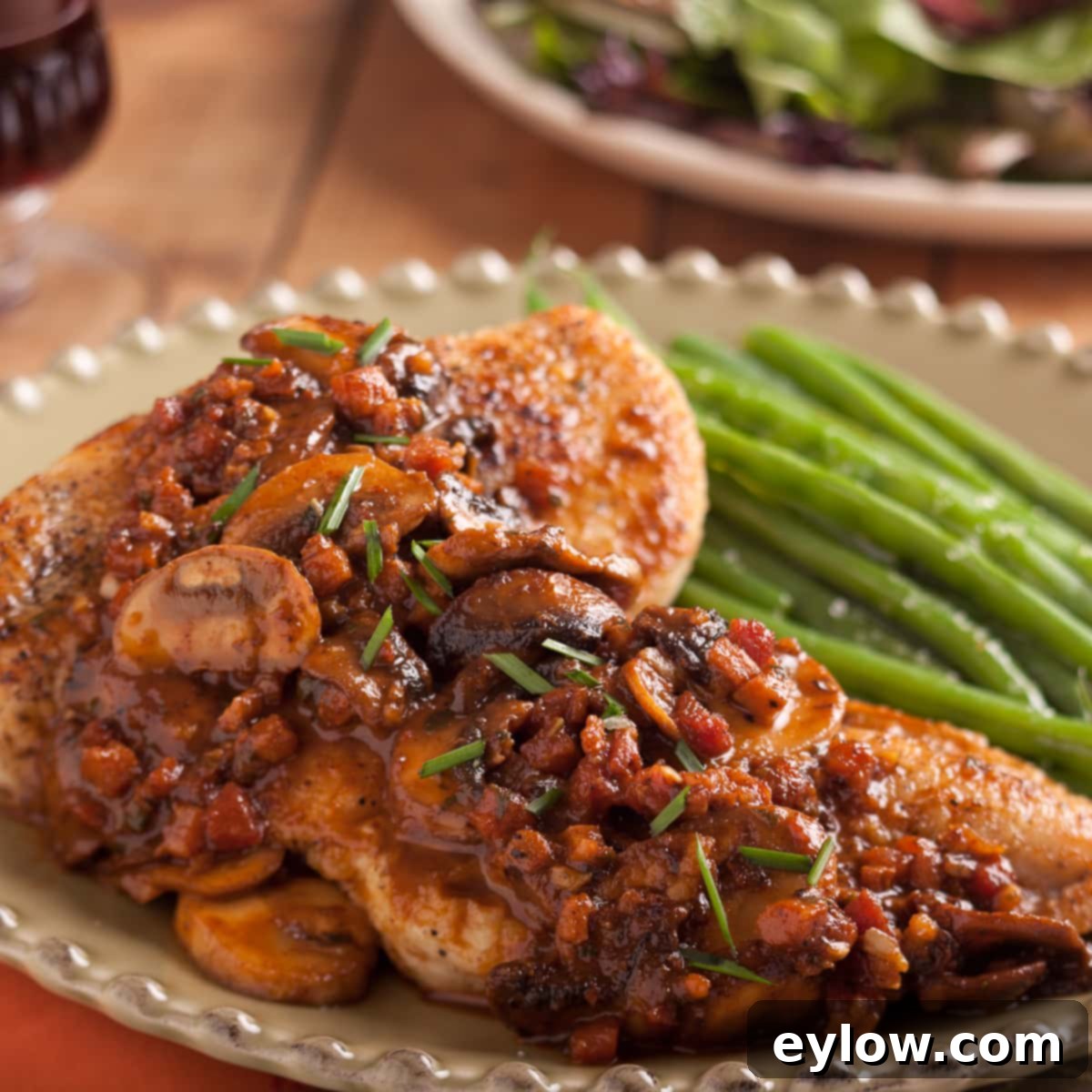Classic Chicken Marsala: An Elegant, Cream-Free Recipe for Weeknights & Special Occasions
Discover the rich, savory flavors of Chicken Marsala, a beloved Italian-American classic that brings gourmet dining to your home. This recipe focuses on creating deeply flavorful golden chicken cutlets, perfectly complemented by an intensely aromatic Marsala wine reduction sauce, brimming with earthy mushrooms and savory pancetta. It’s a dish that feels sophisticated enough for entertaining guests, yet remains wonderfully straightforward for a satisfying weeknight meal. Unlike many versions, our recipe prides itself on a light, yet incredibly rich sauce, achieved without the addition of cream, allowing the pure flavors of Marsala and fresh ingredients to truly shine.
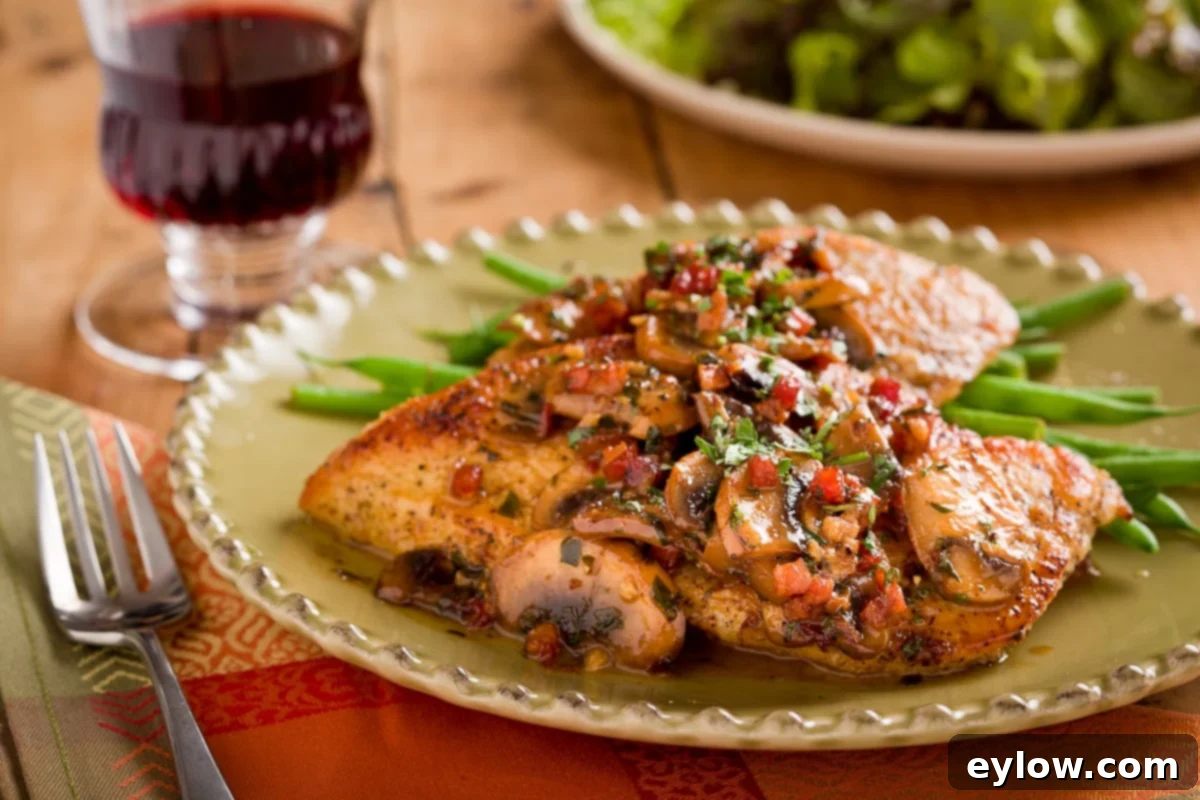
While its name suggests a purely Italian origin, Chicken Marsala is a testament to the culinary creativity that emerged when Italian immigrants adapted traditional recipes using ingredients available in America. This particular rendition emphasizes perfectly cooked, thin chicken cutlets, which we’ll guide you through preparing from scratch, ensuring even cooking and a delightful texture. But before we dive into the cooking process, let’s explore the key ingredients that elevate this dish from good to extraordinary.
Creating succulent chicken cutlets is the first step to a truly authentic Chicken Marsala. Starting with boneless, skinless chicken breasts and transforming them into uniformly thin cutlets ensures they cook quickly and absorb the exquisite Marsala sauce beautifully. This technique not only guarantees tender chicken but also contributes to the dish’s overall elegance and efficiency, making it accessible even on busy evenings. Let’s delve into the essential components that make this chicken Marsala recipe a standout.
[feast_advanced_jump_to]
Essential Ingredient Insights for the Best Chicken Marsala
The magic of Chicken Marsala lies in the quality and balance of its core ingredients. Understanding each component will not only help you choose wisely but also appreciate the depth of flavor they contribute to the final dish. From the fortified wine that gives the dish its name to the savory cured meat and fresh produce, every element plays a vital role.
Understanding Marsala Wine: The Heart of the Sauce
Marsala wine is a fortified wine produced exclusively on the picturesque Italian island of Sicily. Fortification means spirits are added during its production, a process that results in a wine with a higher alcohol content and a richer, more complex flavor profile. When used in cooking, particularly for reduction sauces, Marsala transforms into a velvety, caramelized elixir that forms the foundation of this dish’s distinctive taste.
Marsala wines come in two primary styles: sweet and dry. For savory dishes like Chicken Marsala, dry Marsala is the unequivocal choice. Its subtle nuttiness and nuanced sweetness (despite being “dry”) provide the perfect counterpoint to the chicken and mushrooms, creating a sophisticated depth that sweet Marsala, typically reserved for desserts like Zabaglione, would overpower. When selecting Marsala, look for varieties explicitly labeled “dry” or “secco.” While there are various grades, a good quality cooking Marsala will suffice. If you find yourself without dry Marsala, a dry sherry or even a rich, dry white wine with a splash of brandy can serve as an emergency substitute, though they won’t quite replicate the authentic Marsala flavor.
Pancetta vs. Bacon: The Savory Foundation
Pancetta is an Italian cured pork belly, often referred to as “Italian bacon.” However, a crucial distinction is that traditional pancetta is un-smoked, unlike most American bacon. This means its flavor is purer, less smoky, and more focused on the rich, savory notes of the pork and the spices used in its curing process (often salt, pepper, and nutmeg). This un-smoked quality allows the Marsala wine and mushrooms to take center stage in the sauce, rather than competing with a dominant smoky flavor.
You can typically find pancetta in the deli section of well-stocked grocery stores or at a dedicated deli counter. For the best quality and control over the cut, ask the butcher for a small chunk to dice yourself. This allows you to trim off excess fat if desired, although much of the fat will render out during cooking, contributing essential flavor. Alternatively, many stores offer pre-diced pancetta for convenience, which is perfectly acceptable for this recipe.
During cooking, the pancetta fat renders down, creating a flavorful base for the mushrooms and sauce. After it crisps, the rendered fat is drained off, and the golden, meaty pieces are reintroduced into the sauce at the end. This technique ensures a fantastic burst of savory flavor and a pleasant textural contrast without making the sauce greasy. If pancetta is absolutely unavailable, high-quality, unsmoked bacon or even prosciutto can be used as a last resort, but pancetta offers a unique depth that is truly worth seeking out.
Mushrooms and Fresh Herbs: Earthy Aromatics
Mushrooms are integral to the Marsala sauce, providing an earthy depth and delightful texture. White button mushrooms or cremini (baby bella) mushrooms are commonly used and readily available. They absorb the rich Marsala sauce beautifully, becoming incredibly tender and flavorful. Fresh herbs, particularly oregano and parsley, add a vibrant freshness that brightens the entire dish. While dried herbs can be used in a pinch, fresh herbs offer a superior aromatic quality. Remember to use about one-third the amount of dried herbs compared to fresh, and add them earlier in the cooking process to allow them to rehydrate and release their flavors.

Mastering Chicken Cutlets: The Foundation of Tender Chicken Marsala
Creating thin, even chicken cutlets is a simple technique that dramatically improves the cooking time and tenderness of your Chicken Marsala. It allows the chicken to cook quickly and absorb the flavors of the Marsala sauce more effectively. Here’s a step-by-step guide to achieving perfect cutlets:
- Start with organic, boneless, skinless chicken breasts. Lay a single chicken breast on your cutting board with its rounded, smoother side facing up. If there are any small tenderloins attached, gently pull them off and set them aside; they can be cooked alongside the cutlets.
- Position a sharp chef’s knife in the middle of the chicken breast, typically at the thicker, larger end.
- Carefully slice through the entire length of the chicken breast horizontally. The key is to keep your knife parallel to the cutting board as you slice, effectively butterflying the breast into two thinner, equally sized pieces. Aim to make the two pieces as uniform in thickness as possible for even cooking. If your breast is particularly large, you might even get three thin cutlets from a single breast.
- Once sliced, you’ll have two (or more) thinner cutlets. If any piece is still significantly thicker than the others, you can gently pound it between two pieces of plastic wrap with a meat mallet or the flat side of a heavy pan until it reaches a uniform thickness of about ½ inch. This ensures all pieces cook at the same rate and remain incredibly tender.
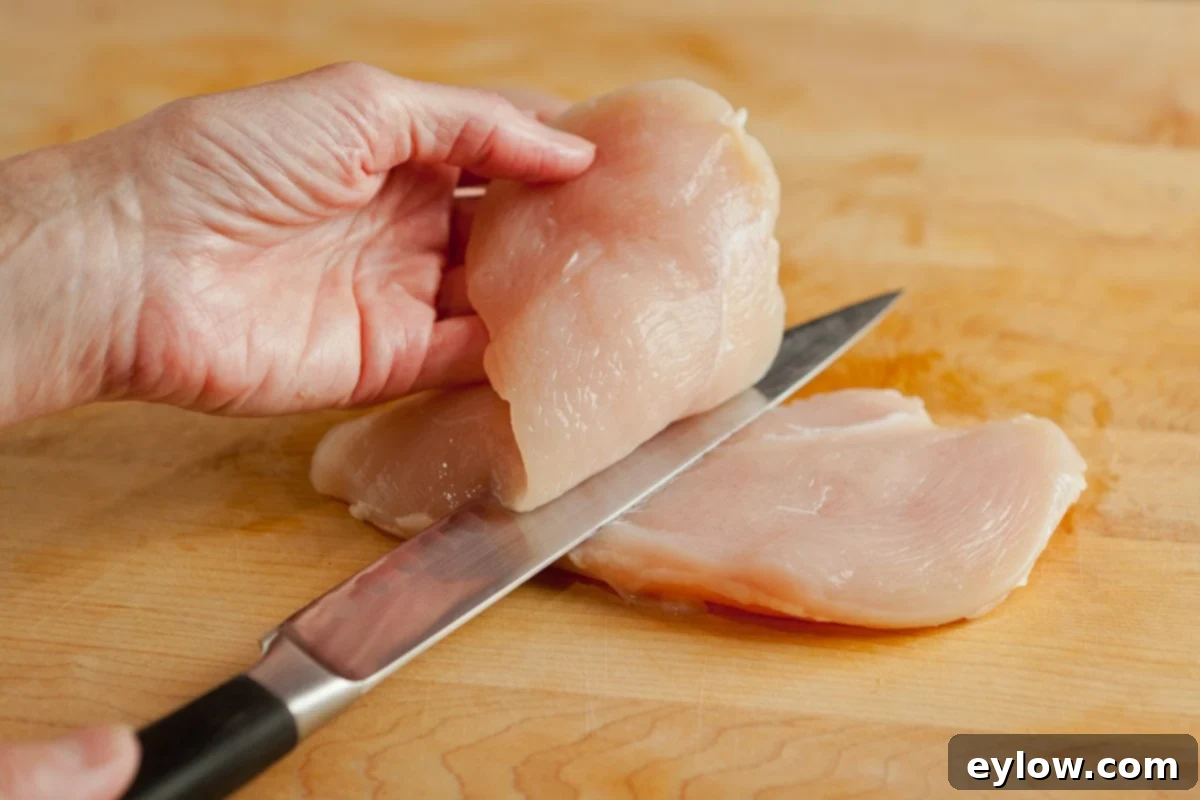
Seasoning and Flour Dusting: The Secret to Golden Perfection
Proper seasoning and a light dusting of flour are crucial steps to creating a beautifully crisp and flavorful crust on your chicken cutlets, which then becomes part of the rich Marsala sauce. This exterior texture is what gives the chicken its signature “golden” quality.
Once your chicken cutlets are uniformly thin, generously sprinkle both sides with high-quality salt, freshly ground black pepper, and granulated garlic. Granulated garlic is preferred over garlic powder as it’s less prone to burning and offers a more robust flavor. After seasoning, lightly dust or coat each cutlet with your chosen flour. The flour acts as a protective coating, helping the chicken to brown beautifully and preventing it from sticking to the pan. It also provides a slight thickening agent for the sauce that will later be built in the same pan.
- For those adhering to a gluten-free diet, excellent alternatives include a general-purpose gluten-free flour blend, cassava flour, rice flour, or coconut flour. These options provide a similar crispness.
- If using wheat flour, white whole wheat flour is a fantastic choice, offering a slightly nuttier flavor and increased nutritional value compared to all-purpose flour, without being too heavy.
The goal is a light, even coating – shake off any excess flour. A thick coating can become pasty. For a truly grain-free or Paleo approach, you can skip the flour entirely. While the chicken won’t develop quite the same crisp crust, it will still taste fantastic and cook beautifully, allowing the natural flavor of the chicken to shine through the sauce.
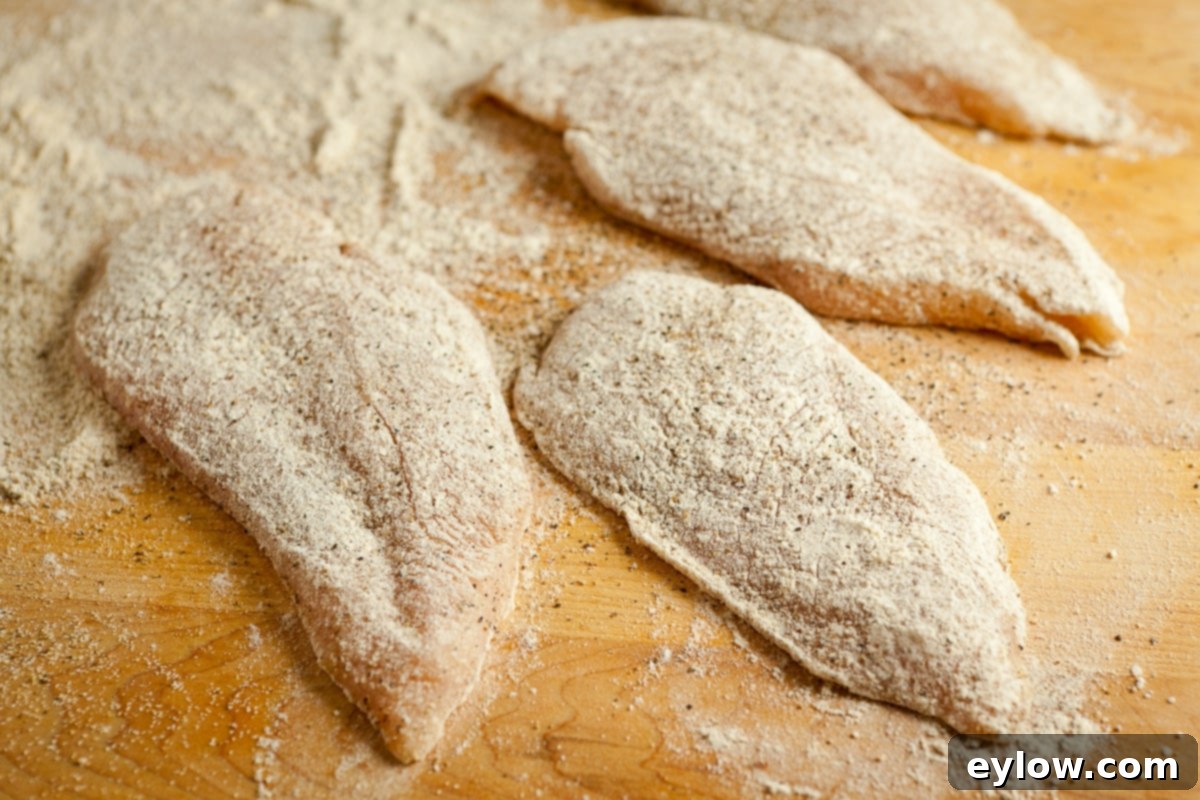
Achieving Golden Perfection: Cooking the Chicken Cutlets
Cooking the chicken cutlets correctly is key to their tender texture and golden-brown exterior, which is essential for building the foundational flavor of your Marsala sauce. This step should not be rushed.
Begin by heating a medium to large sauté pan or skillet over medium heat. The pan should be hot enough to sizzle when the chicken is added, but not so hot that the flour burns. Add your cooking fat: a combination of extra virgin olive oil and butter is traditional and imparts a rich flavor and beautiful browning, but you can use all olive oil for a non-dairy option. Once the fat is shimmering but not smoking, carefully add the seasoned and floured chicken cutlets to the pan.
Cook the cutlets until they achieve a gorgeous golden-brown crust on the first side. This usually takes about 3-5 minutes, depending on the thickness of your chicken and the heat of your pan. You’ll notice the edges of the chicken starting to turn opaque and white as it cooks through. Once golden, flip the cutlets and cook for another 1-2 minutes until they are fully cooked through and golden on the second side. Properly cooked cutlets will feel firm to the touch, with just a slight give in the center. Avoid overcooking, as this can make the chicken dry and tough.
Important Tip: Depending on the size of your pan and the number of cutlets, you may need to cook the chicken in two or even three batches. Overcrowding the pan will lower the temperature, cause the chicken to steam rather than sear, and prevent that desirable golden crust from forming. Once each batch is cooked, transfer the cutlets to a plate and keep them warm in a low oven (around 175°F-200°F) while you prepare the glorious Marsala sauce in the very same pan.
Dairy-Free Option: To make this recipe completely non-dairy, simply use a high-quality plant-based butter or stick to using only olive oil for cooking the chicken. The flavor will still be outstanding!
Crafting the Irresistible Marsala Sauce
The beauty of this recipe truly unfolds as you build the Marsala sauce in the same pan where the chicken was cooked. Those browned bits (fond) left behind in the pan are packed with flavor and are the secret to a truly rich and complex sauce. This cream-free sauce relies on the reduction of Marsala wine, combined with the savory notes of pancetta, earthy mushrooms, aromatic garlic, and a hint of tomato paste, along with fresh herbs, to create an irresistible symphony of flavors.
- Render the Pancetta: Start by adding the finely chopped pancetta to the same pan (no need to clean it). Cook over medium heat, stirring occasionally, until the pancetta is beautifully crisp and golden. As it cooks, it will render out a significant amount of its fat. Once crisp, carefully remove the pancetta from the pan using a slotted spoon and drain it on several layers of paper towels. Leave about 1-2 tablespoons of the rendered pancetta fat in the pan; drain off any excess, as this fat will provide an incredibly flavorful base for the mushrooms.
- Sauté the Mushrooms: Add the sliced mushrooms to the pan, stirring to coat them in the leftover pancetta fat. It might seem like a lot of mushrooms at first, and the pan might appear dry, but as the mushrooms cook, they will release their moisture and shrink significantly. Continue to cook them, stirring occasionally, until they have given off their liquid and have started to brown beautifully. This browning develops a deep, umami flavor. If the pan seems too dry at any point, you can add a tiny splash more olive oil or a knob of butter.
- Build the Flavor Base: Once the mushrooms are browned, add the minced garlic and tomato paste to the pan. Stir constantly for about 1 minute, allowing the garlic to become fragrant and the tomato paste to deepen in color. Cooking the tomato paste briefly helps to toast it and unlock its concentrated, sweet-savory flavor.
- Deglaze and Reduce with Marsala: This is where the magic happens! Move the pan off the burner for a moment. Carefully pour the dry Marsala wine into the pan.
- Return the pan to medium-high heat. Bring the Marsala wine to a gentle simmer and cook it down until it has reduced by about half and starts to thicken, becoming slightly syrupy. This reduction process concentrates the wine’s flavor, mellowing its alcoholic edge and intensifying its rich, caramelized notes. Stir in the fresh chopped oregano (or rehydrated dried oregano if using).
- Finishing Touches: Add the drained, crisp pancetta back into the sauce. If you desire a slightly richer finish, you can stir in 2 tablespoons of unsalted dairy or plant-based butter at this stage, allowing it to melt and emulsify into the sauce, adding a lovely gloss and depth. Taste the sauce and adjust seasoning with salt and pepper as needed.
Safety Tip: Marsala wine can contain up to 20% alcohol, which means it can ignite when poured into a hot pan. For your safety, always remove the pan from the direct heat source when adding the wine. Once the wine is in, you can carefully slide the pan back onto the burner.
This Marsala sauce, with its complex flavors and delightful texture, is the perfect complement to the golden chicken cutlets, creating a harmonious and utterly delicious dish.
Serving Your Homemade Chicken Marsala
Presenting your Chicken Marsala beautifully enhances the dining experience, whether it’s for a family dinner or a special gathering. The elegant presentation makes it feel even more special than it already is.
For a classic family-style presentation, arrange the golden-brown chicken cutlets artfully on a warm serving platter. Then, generously spoon the rich, mushroom-and-pancetta Marsala sauce over the top of the chicken, ensuring every piece is coated in its flavorful embrace. If desired, garnish with a sprinkle of fresh chopped parsley or additional fresh oregano to add a pop of color and a final aromatic touch. The vibrant green against the deep brown sauce and golden chicken is truly appealing.
Serve immediately to enjoy the chicken and sauce at their best, alongside your chosen side dishes. The aroma alone will have everyone eager to dig in!
Storing and Reheating Leftovers
One of the many great things about Chicken Marsala is that it makes for excellent leftovers. The flavors often meld and deepen even further overnight, making it just as delicious, if not more so, the next day.
Allow any leftover Chicken Marsala to cool completely to room temperature before storing. Transfer the chicken and sauce to an airtight container. Properly stored, leftovers will keep beautifully in the refrigerator for up to 4 days. When reheating, gently warm the chicken and sauce in a skillet over medium-low heat on the stovetop, or in the microwave, until heated through. Add a splash of chicken broth or water if the sauce appears too thick after refrigeration.
Perfect Pairings: What to Serve with Chicken Marsala
Chicken Marsala is a versatile main course that pairs wonderfully with a variety of side dishes, allowing you to create a complete and satisfying meal. Here are some excellent suggestions:
- Green Vegetables: A vibrant green vegetable provides a fresh contrast to the rich sauce. Consider simply steamed or sautéed baby green beans, tender asparagus, or crisp broccolini drizzled with olive oil and a sprinkle of finely grated Parmesan cheese. A fresh, tossed green salad with a light vinaigrette is also a fantastic option.
- Pasta: For a more substantial meal, serve Chicken Marsala alongside a simple pasta dish. Cooked whole wheat or gluten-free pasta tossed lightly with extra virgin olive oil and a generous sprinkle of good quality Parmesan cheese is a classic pairing. The pasta provides a wonderful vehicle to soak up every drop of that delicious Marsala sauce.
- Potatoes: Potatoes offer a comforting and hearty accompaniment. Roasted red potatoes with rosemary are particularly delightful, their crispy exteriors and fluffy interiors complementing the chicken beautifully. Creamy mashed potatoes or a light potato gratin would also be excellent choices.
- Rice or Polenta: For something different, consider serving your Chicken Marsala over a bed of fluffy white rice, brown rice, or a creamy, savory polenta. These options also excel at absorbing the rich sauce.
Choose one or two of these side dishes to create a well-rounded and truly terrific dinner that highlights the exquisite flavors of your homemade Chicken Marsala.
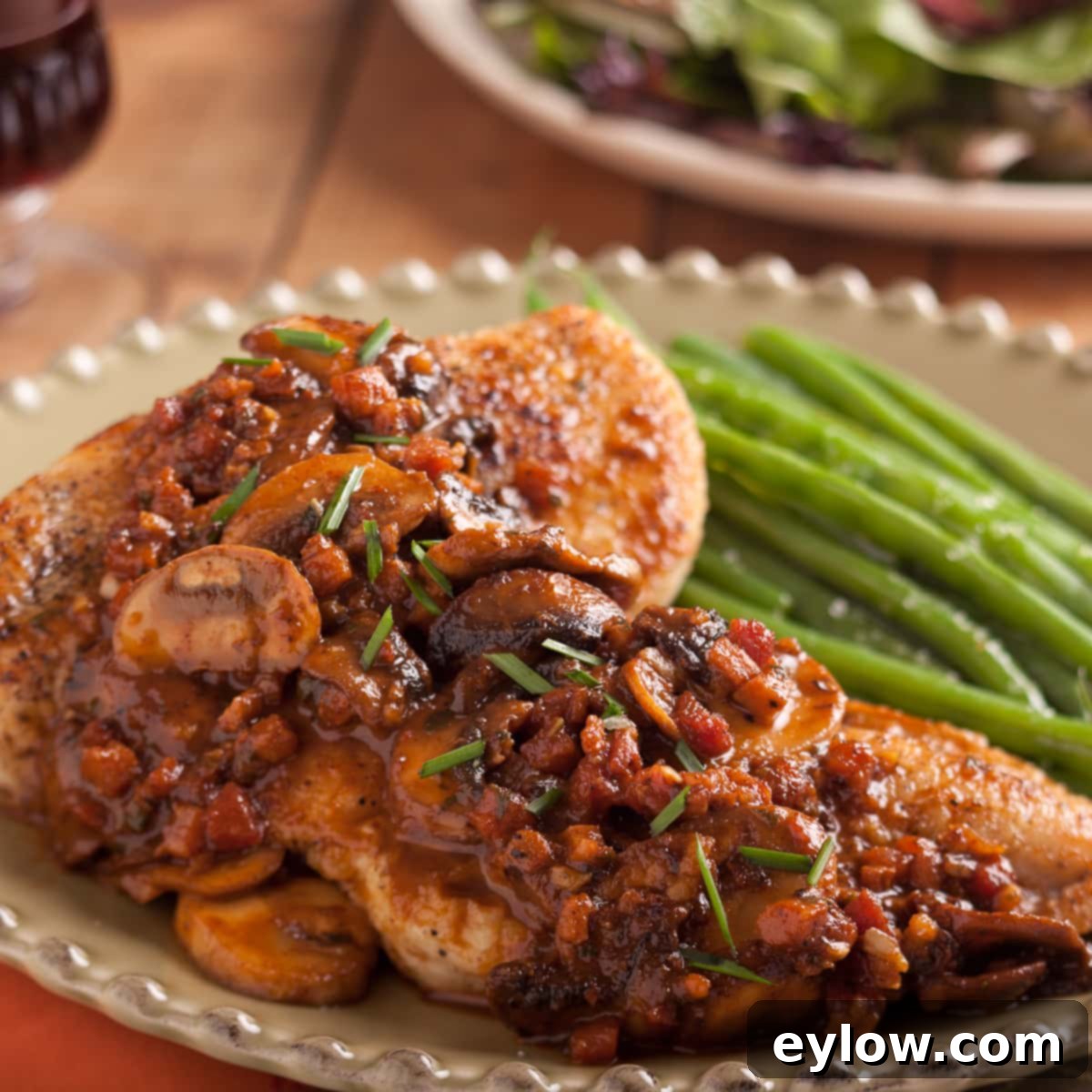
📖 Recipe: Classic Chicken Marsala (Cream-Free)

Chicken Marsala (Without Cream)
Sally Cameron
Pin Recipe
Equipment
-
Saute or fry pan
Ingredients
Chicken Cutlets
- 1 ½ pounds organic boneless skinless chicken breasts
- sprinkles salt
- sprinkles ground black pepper
- sprinkles granulated garlic
- ½ cup flour: cassava, coconut, rice or white whole wheat
- 2 tablespoons extra virgin olive oil oil and butter combo is nice too
Marsala Sauce
- 3 ounces Pancetta chopped small
- 12-16 ounces white or brown mushrooms washed and sliced thin
- 2 large garlic cloves chopped fine
- 1 tablespoon tomato paste freeze extra for future use
- 1 ½ cups dry Marsala wine 12 ounces
- 1 tablespoon fresh chopped oregano 1 teaspoon dried
- 1 tablespoon fresh chopped parsley optional for garnish
- 2 tablespoons unsalted dairy or plant butter optional
Instructions
Slice and Season Cutlets
-
Carefully place your chicken breasts flat on a clean cutting surface, ensuring the smoother, rounded side is facing up. If present, remove any small tenderloins and set them aside to cook later with the cutlets. Using the palm of your non-dominant hand, gently but firmly press down on the chicken breast. With a thin-bladed, very sharp knife, meticulously slice each chicken breast horizontally through its length, aiming to create two equal, thin pieces. It’s crucial to keep your knife perfectly parallel to the cutting board throughout this process to ensure uniform thickness. Once sliced, season both sides of the chicken cutlets generously with salt, freshly ground black pepper, and granulated garlic. Finally, lightly sprinkle your chosen flour over both sides of each cutlet, ensuring an even, thin coating, then gently shake off any excess flour.
Cook Cutlets
-
Heat a large sauté or fry pan (approximately 11″-12″ in diameter) over medium heat until hot. Add the extra virgin olive oil (or an oil and butter combination for added richness). Once the oil is shimmering, carefully place the floured chicken cutlets into the pan, rounded side down first. Allow the cutlets to cook undisturbed until they develop a beautiful golden-brown crust. You’ll notice the edges of the chicken beginning to turn opaque (cooked) as an indicator that they are nearly ready to flip. Turn the cutlets and continue cooking for another 1-2 minutes, depending on their thickness, until they are fully cooked through and golden on the second side. When done, they should feel firm to the touch with just a slight give. Remove the cooked cutlets from the pan and keep them warm on a plate in a low oven (175°F-200°F) while you prepare the sauce.
Make the Marsala Sauce
-
Prepare a small plate by folding several layers of paper towels, which will be used for draining. Return the same pan (without cleaning it, as the leftover fond adds flavor) to medium heat. Add the chopped pancetta and cook, stirring occasionally, until it becomes wonderfully crisp and golden. Once cooked, use a slotted spoon to transfer the pancetta onto the prepared paper towels to drain off the excess fat. Leave approximately 1-2 tablespoons of the rendered pancetta fat in the pan for the next step.
-
In the same pan, over medium heat, add the thinly sliced white or brown mushrooms. Initially, the pan may appear dry, but as the mushrooms cook, they will release their moisture. Stir occasionally and allow them to cook until all their moisture has evaporated and they begin to brown and caramelize, developing a rich, earthy flavor. If at any point the pan seems excessively dry before the mushrooms release their liquid, you may add a very small amount of olive oil or butter.
-
Reintroduce the drained, crispy pancetta into the pan along with the finely chopped garlic and tomato paste. Cook for 1 minute, stirring constantly, to allow the garlic to become fragrant and the tomato paste to toast slightly, intensifying its flavor. Next, carefully add the dry Marsala wine to the pan (remember to move the pan off the burner briefly when adding the wine for safety, then return it). Bring the mixture to a simmer and cook until the wine is reduced by approximately half and begins to thicken into a slightly syrupy consistency. Stir in the fresh chopped oregano (or rehydrated dried oregano). To serve, arrange the warm chicken cutlets on individual plates and generously spoon the delicious Marsala sauce over the top. Garnish with fresh chopped parsley if desired.
